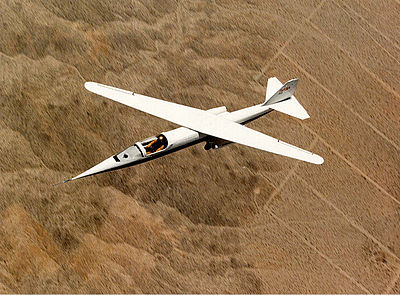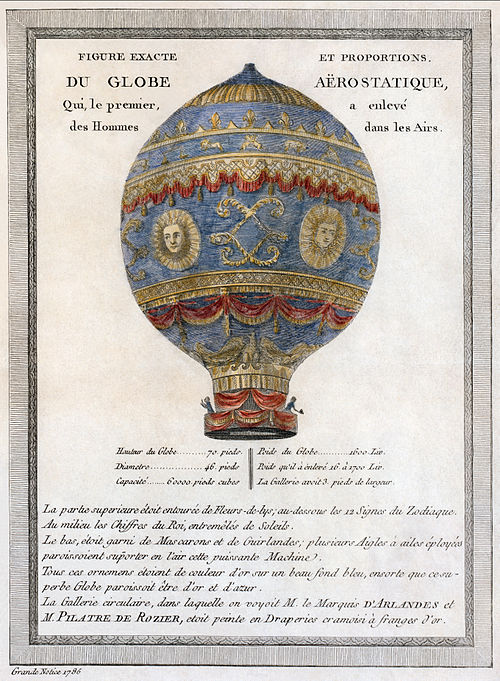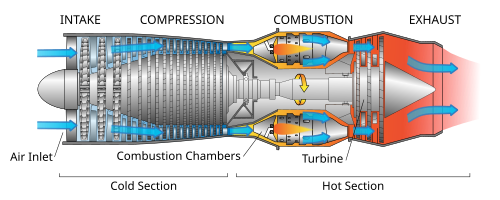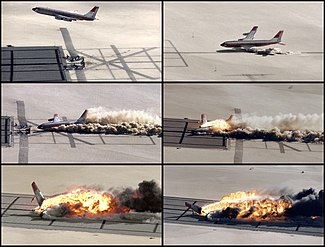Portal:Aviation/Selected picture
Selected pictures
Usage
- Add a new Selected article to the next available subpage. Use {{Portal POTD}} or {{Selected picture}}.
- Update
|max=to new total for its {{Random portal component}} on the main page.
1
F-16 Fighting Falcons with the U.S. Air Force Thunderbirds aerial demonstration team fly in delta formation in front of the Empire State Building during an air show. The F-16 Fighting Falcon is a modern multi-role jet fighter aircraft built in the United States. Designed as a lightweight fighter, it evolved into a successful multi-role aircraft, and is serving with 25 countries.
2
Coloured smoke reveals a vortex of air created by the wing of an airplane, also known as wake turbulence or jetwash. This turbulence can be especially hazardous during the landing and take off phases of flight, where an aircraft's proximity to the ground makes a timely recovery from turbulence-induced problems unlikely.
3
A cutaway digram of an aircraft hangar.
4
KC-10 Extender during Operation Iraqi Freedom.
5
Antonov An-225 Mriya (the largest freight aircraft), the Boeing 747-8 Intercontinental (soon to be the largest version of the Jumbojet), and the Airbus A380-800 (the largest passenger aircraft).
6
air superiority in aerial combat. As of 2005, the F-15 in all air forces has a combined kill record of 104 confirmed kills to zero losses in air combat, although some F-15s have been claimed by surface-to-air missiles.
7
C-124 Globemaster II.
8
Goodyear Zeppelin Corporation in Akron, Ohio. She cast off for her maiden voyage on 2 November 1931, but crashed less than two years later.
9
ejector seats were developed during the war by Heinkel. Early models were powered by compressed air and the first aircraft to be fitted with such a system was the Heinkel He 280 prototype jet fighter in 1941. One of the He 280 test pilots, Dipl.-Ing. Rudolf Schenk, flying for Argus, became the first person to escape from a stricken aircraft with an ejector seat on January 13, 1942. During a flight with the still engine-less V-1 towed by a Heinkel He 111 he had to leave his airplane because he could not release the towing cable due to icing of the coupling. By December 2003, Martin-Baker ejector seats had saved 7028 lives. The total figure for all types of seat is unknown but must be considerably higher.
10
V-2 rocket at Peenemünde. Along with his team of engineers, he surrendered to the American forces in the closing stages of the war, then helped to establish the military rocket program in the United States. In 1958 he transferred to the newly established NASA program, developing the Saturn V rocket that successfully delivered a man to the moon in 1969.
11
vapour trails over Antarctica as it prepares for an airdrop during Operation Deep Freeze.
12
George Cayley's glider, created in 1853.
13
F-15D Eagle from the 325th Fighter Wing based at Tyndall Air Force Base, Florida releasing flares. The F-15 is a multi-role tactical fighter designed by McDonnell Douglas. The first flight of the F-15A was in July 1972, but since then it has been produced in six model variations with both single seat and dual seat versions. The original and largest operator of the F-15 is the United States Air Force, but it is also operated by the air forces of Israel, Japan, Saudi Arabia and South Korea.
14
French Gendarmerie rescue helicopter taking off on the Massif du Sancy mountains, France.
15
16
San Francisco International Airport (IATA: SFO) opened on May 7, 1927 on 150 acres (607,000 m²) of cow pasture leased from prominent local landowner Ogden L. Mills, and was named Mills Field Municipal Airport. During the economic boom of the 1990s and the dot-com boom, SFO became the 6th busiest international airport in the world. However, since the boom times ended, it has fallen back out of the top twenty.
17
Boeing 747-200.
18
C-17 Globemaster III releasing a flare.
19
aeroplane is always falling. However a pilot can gain height by circling within a strong thermal — a column of air that is rising at a faster rate than the plane is falling. On a good day, an experienced pilot can travel hundreds of miles before landing.
20
Ellsworth AFB, South Dakota.
21
Jet-A fuel.
22
A pushback tractor attached to the front wheel of a Boeing 777. The vehicle is used to push the airplane out from the gate, before it starts taxiing on its own power. See Image:Denver International Airport, United Airlines Boeing 777 being serviced.jpg for a wider-view photo taken at the same time, from nearly the same angle.
23
RQ-4 Global Hawk is an unmanned aerial vehicle (UAV) used by the US Air Force as a surveillance aircraft.
24
airbases.
25
US Air Force aircraft designed exclusively for close air support
.
The A-10 was developed in response to the increasing vulnerability of ground attack-planes to A-1 Skyraider.
26
three kingdoms era used airborne lanterns for military signalling.
27
X-13 Vertijet was designed to explore the feasibility of a pure-jet vertical takeoff and landing (VTOL) fighter aircraft. Here, the X-13 is about to moor itself to a dual-role flatbed transport/launch trailer.
28
A test firing of twin linear XRS-2200 Aerospike engines. The aerospike engine is a type of rocket engine that maintains its efficiency across a wide range of altitudes through the use of an aerospike nozzle.
A standard rocket engine uses a bell shaped
air pressure which reduces as the rocket climbs. An aerospike uses the air flowing past the rocket to form half of a 'virtual bell' which automatically compensates for the reducing pressure.
29
airshow at Langley Air Force Base, Virginia, USA. The P-51 was a long-range single-seat fighter aircraft that entered service with Allied air forces in the middle years of World War II. It remained in service with some air forces until the early 1980s.
30
flight control system consists of the flight control surfaces, the respective cockpit controls, connecting linkage, and necessary operating mechanisms to control aircraft in flight.
31
F/A-18C Hornet, assigned to the "Golden Dragons" of Strike Fighter Squadron One Nine Two (VFA-192), launches from the flight deck of the conventionally powered aircraft carrier USS Kitty Hawk (CV 63). Kitty Hawk and embarked Carrier Air Wing Five (CVW-5) are currently returning to their homeport after a scheduled deployment in the 7th Fleet area of responsibility.
32
A newsreel showing the breaking of the sound barrier on 14 October 1947 by Chuck Yeager in the rocket-powered Bell X-1. Flying at an altitude of 45,000 ft (13.7 km), Yeager became the first person to break the sound barrier in level flight.
33
Nevada test Site, August 7, 1957. The tail, or “After” section of a U.S. Navy Blimp is shown with the Stokes cloud in background. Blimp was in temporary free flight in excess of five miles from ground zero when collapsed by the shock wave from the blast. The airship was unmanned and was used in military effects experiments on blast and heat. Navy personnel on the ground in the vicinity of the experimental area were unhurt. On ground to the left are remains of the forward section.
34
freefall for 4.5 minutes at speeds up to 625 mph (1,005 km/h) and temperatures as low as −94°F (−70°C), he opened his parachute at 17,500 feet (5.3 km). The whole descent took 13 minutes and 45 seconds. This is the current world record for the highest parachute jump and was the longest freefall until Adrian Nicholas broke the record in 1998 with a wingsuit skydive lasting 4 minutes 55 seconds.
35
Operation Desert Storm in 1991.
36
Runway markings
37
radar signature. The aircraft flew so fast and so high that if the pilot detected a surface-to-air missile launch, the standard evasive action was simply to accelerate. During its entire operational life, more than 3,000 missiles were fired at the aircraft, yet no SR-71 was ever shot down.
38
An attitude indicator (AI), gyro horizon or artificial horizon, is an instrument used in an aircraft to inform the pilot of the orientation of the airplane relative to earth.
39
B-25 Mitchell
Credit: Alfred T. PalmerAssembling B-25 bombers at North American Aviation -- Kansas City, Kansas; Reproduction from color slide
40
User:Duk
Animation of a radial engine






































